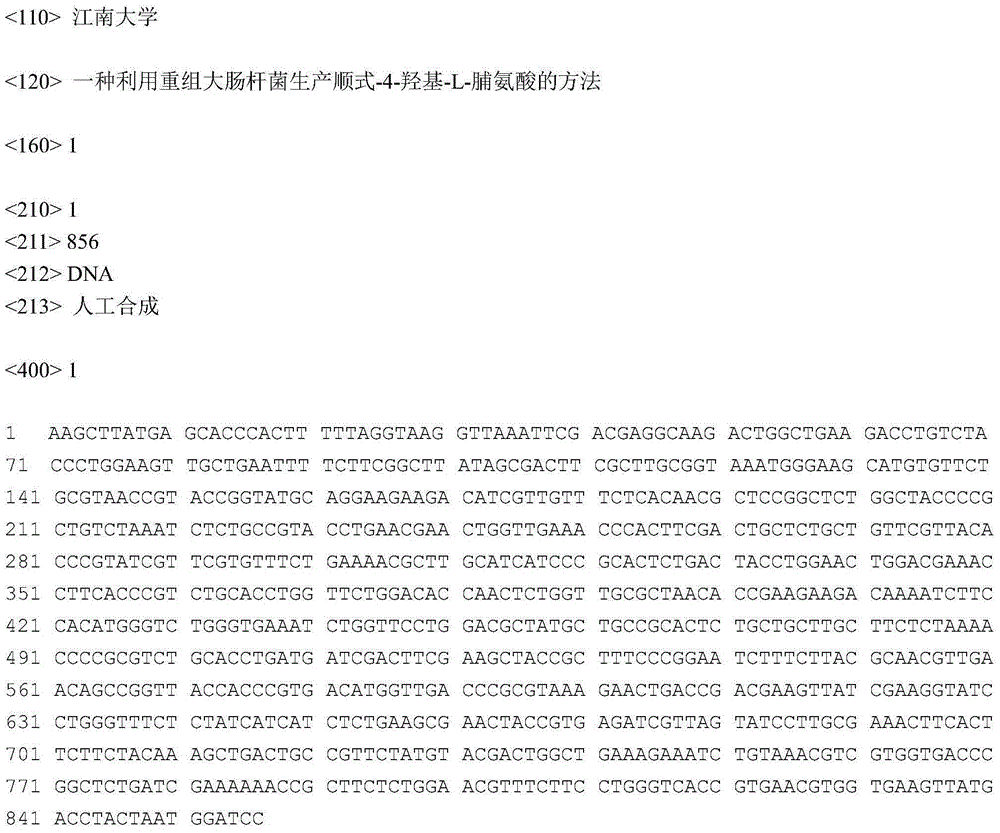Method for producing cis-4-hydroxy-L-proline through recombinant escherichia coli
A production method, proline technology, applied in the fields of biochemical equipment and methods, recombinant DNA technology, botany equipment and methods, etc.
- Summary
- Abstract
- Description
- Claims
- Application Information
AI Technical Summary
Problems solved by technology
Method used
Image
Examples
Embodiment 1
[0023] Embodiment 1: the design of proline-cis-4-hydroxylase gene sequence
[0024] According to the codon usage frequency of Escherichia coli to optimize gene codons, eliminate low-usage codons, and use the synonymous transformation method to eliminate Hind Ⅲ, BamH I restriction sites, and modify the stop codon in the original sequence to TAAT strong terminator, in order to facilitate the connection of the proline-cis-4-hydroxylase gene to other vectors, a Hind III restriction site was added before the start codon, and an enzyme was inserted behind the terminator Cutting site BamH Ⅰ.
[0025] The secondary structure of mRNA should also be considered to ensure that the codon translation pocket consisting of the AUG start codon and a few bases after it is open, reducing the energy potential of ribosomes binding to mRNA, so that ribosomes can smoothly Translate backwards along the start codon.
[0026] The original sequence of the proline-cis-4-hydroxylase gene sequence in thi...
Embodiment 2
[0027] Embodiment 2: Construction of proline-cis-4-hydroxylase gene expression vector and recombinant Escherichia coli
[0028] On the pES vector containing the tryptophan tandem promoter (ptrp2), there are Hind III and BamH I restriction sites at the 3' end of the promoter, and the synthetic proline-cis-4-hydroxylase gene The 5' end sequence has a Hind Ⅲ restriction site, and the 3' end has a BamH Ⅰ restriction site, so both Hind Ⅲ and BamH Ⅰ are used for the pES vector and proline-cis-4-hydroxylase gene After double enzyme digestion and gel recovery, the gel recovery product was ligated with T4DNA ligase.
[0029] The ligation solution was transformed into Escherichia coli JM109 competent cells, and then the plasmids were extracted for enzyme digestion verification, and the plasmids with correct enzyme digestion results were sequenced to verify whether the gene sequence was correct. In this way, the constructed pEHC4 recombinant vector was obtained, and the map of the recom...
Embodiment 3
[0030] Then, the verified recombinant vector was transformed into Escherichia coli BL21(DE3) to obtain recombinant Escherichia coli BL21(DE3) / pEHC4. Embodiment 3: Fermentation experiment of recombinant escherichia coli BL21(DE3) / pEHC4
[0031] Seed culture: Pick a single colony of recombinant Escherichia coli BL21(DE3) / pEHC4 on the Amp resistant plate, inoculate it into LB liquid medium (ampicillin 100 μg / mL), and culture it at 37°C and 220rpm for 6-8h.
[0032] Shake flask fermentation: Inoculate 6% inoculum into a 250mL shake flask containing 30mL GT medium, culture in a rotary shaker at 25°C and 220rpm for 48h, then take the fermentation broth to detect cis-4-hydroxy-L- Proline concentration.
[0033] Yield determination: For the determination method of cis-4-hydroxy-L-proline, please refer to the general description of the examples.
[0034] The fermentation results showed that the cis-4-hydroxyl-L-proline yield of the recombinant Escherichia coli BL21(DE3) / pEHC4 reached...
PUM
 Login to View More
Login to View More Abstract
Description
Claims
Application Information
 Login to View More
Login to View More - R&D
- Intellectual Property
- Life Sciences
- Materials
- Tech Scout
- Unparalleled Data Quality
- Higher Quality Content
- 60% Fewer Hallucinations
Browse by: Latest US Patents, China's latest patents, Technical Efficacy Thesaurus, Application Domain, Technology Topic, Popular Technical Reports.
© 2025 PatSnap. All rights reserved.Legal|Privacy policy|Modern Slavery Act Transparency Statement|Sitemap|About US| Contact US: help@patsnap.com


